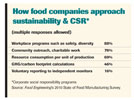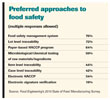

Many factors are at play in the industry’s reclaimed optimism, from improved credit availability to positive outcomes from continuous improvement efforts. One of the more underappreciated factors is Americans’ shift toward in-home meals as a belt-tightening tactic. While products that target the retail channel require more elaborate packaging and greater human input to produce than foodservice products, the payoff is higher margins.
More than one in fourFood Engineeringreaders who responded to the survey of multiple choice and open-ended questions indicate their companies are shifting focus away from foodservice and toward production of retail products. That’s almost 50 percent more than the number who indicated a similar shift in 2009. More appealing package graphics, portioning automation, a greater “focus on innovating the retail footprint” and “shorter manufacturing runs, more changeovers” are among the necessary changes cited in making the transition.

More spending on equipment upgrades is needed to maintain the upward curve in productivity. Asked to rate 18 methods for improving productivity, survey respondents rank equipment upgrades as the top need at their facilities. The ranking is consistent with surveys in recent years, but the proportion indicating the importance of these upgrades is growing, with almost one in five giving it a high priority. Upgrades to plant controls architecture ranks as the fifth-highest priority, behind operator skill training, line supervisor skill training and improved maintenance systems. A year ago, controls architecture ranked 15th.

Now hiring
The lights-out factory remains more fantasy than reality, at least in food and beverage production, and people are needed to optimize the value of equipment upgrades and automation investments. The most dramatic structural changes in the last year involve personnel, and the good news outweighs the bad.Almost a quarter (23 percent) of survey respondents report their companies added engineers to the staff in the last year, compared to only one in 10 in 2009. True, 8 percent downsized their engineering staffs, but that was an improvement over 2009, when 14 percent made cuts. Plus, the proportion hiring engineers is the highest in at least eight years.
A year ago, 17 percent of companies were adding personnel, and 21 percent were downsizing. But in 2010, fully one in four companies beefed up their overall manufacturing workforces, while only 13 percent made cuts. It’s the highest proportion of manpower additions in four years.
Additionally, fewer firms are outsourcing more work to copackers (11 percent, down from 14 percent), and one in 10 is adding production shifts, suggesting greater confidence in sustained sales growth. Slightly more readers report their firms built a new plant than in the two previous surveys, though that is not representative of the industry. Major expansions and greenfield projects nationwide are off 19 percent from their 15-year average (see related chart on page 56).

The trends that stand out include food safety and the impact of international standards for third-party audits, along with the focus on continuous improvement (Six Sigma, Lean, etc.) and shifting patterns in consumer preference, in particular demand for individual portions instead of family meals. Also of note are energy conservation and other sustainability initiatives, notably green packaging. Shifting product preferences is the wild card, and those shifts manifest themselves in various ways.
“Healthy/natural/organic/locally grown: The push to process food less, purchase from local sources, [reduce] childhood obesity and eating healthy are all daily topics to deal with,” one reader writes. Adds another, “Consumer needs change, and we want to keep up with those changes.” The growth of private-label alternatives is cause for concern for brand owners. “Consumer use of lower-margin brands will impact profitability,” one respondent frets. Acknowledging the constrained family food budgets many Americans have, another reader summarizes, “Consumer behavior: What type of meal do they want and can they afford?”
Personnel issues are on many industry professionals’ radar. “Adding more engineers/staff at manufacturing facilities,” one writes. Attracting new workers and training them, particularly as skilled technicians currently on staff retire, is a concern. And although grousing about regulations and government mandates often crops up, the demands of retail customers bother many professionals even more. “Demands from larger retailers for customized offerings,” is a top trend one reader mentions. “Customer requiring special products, wanting their own special product, which means shorter runs and more changeovers,” another elaborates. “Customers are buying based on price vs. quality or past experiences,” complains a third.

Quality assurance measures
Most customers require HACCP planning, regardless of whether USDA or FDA regulations stipulate it for a particular product, and virtually every food and beverage manufacturer includes HACCP as part of a comprehensive approach to food safety. Based on survey responses, a third of the industry has taken it to the next level, implementing electronic HACCP record keeping, and half of those companies are assuring the integrity of their data by incorporating electronic signatures for processing steps (see chart on page 50).The early 2009 peanut recall was fresh in readers’ minds last year when almost half supported the idea of more rigorous, independent audits to counter widespread recalls due to contaminated ingredients. This year, only a third supports rigorous audits, and one-fourth dismisses the standardized audits under the Global Food Safety Initiative (GFSI) as another costly, time-consuming plant review. But another quarter indicates global standards will help restore confidence in the third-party audit system, and a similar proportion believes GFSI will add transparency to the current system (see chart on page 58).
Although GFSI proponents have suggested rigorous third-party reviews might lead to less-frequent plant audits and could demonstrate the effectiveness of industry self-policing, few respondents view those as likely outcomes. Only one in nine believes GFSI will result in fewer audits; one in 12 thinks it will head off stricter food safety regulations. Nonetheless, several readers cite global food safety standards as a key shaper of manufacturing operations, in part because foodservice and retail customers will demand compliance.
More than four in five respondents indicate their companies have a social responsibility or sustainability program. The most common manifestation is workplace programs, such as worker safety initiatives and diversity programs. Community outreach programs such as charitable contributions and volunteerism are in place at three-quarters of respondents’ companies. Efforts to control resource use prompts two-thirds of the organizations to calculate water and electric use on the basis of units of production, and almost half are calculating their carbon footprints.
One in six of companies with a sustainability program reports its greenhouse gas emissions to independent bodies such as the Global Reporting Initiative. Recycling initiatives, tapping methane from landfills as an energy source, and sustainable packaging and agriculture practices are among the open-ended mentions, along with “pride.”

Although automation investments are destined to continue, respondents don’t view the spending as a panacea. Of the plants with asset-management systems, for example, 58 percent indicate the system has not produced a return on investment, up from 49 percent a year ago. Only one in five pegs ROI at 7 percent or higher.
By contrast, enthusiasm for personnel-driven initiatives appears to be escalating. Half of respondents indicate a lean manufacturing program is part of their organization’s continuous improvement effort, with almost a third deploying Six Sigma, Total Quality Management and self-directed work teams. Other mentions include OEE programs, holistic margin management and Nestlé Continuous Excellence.

Survey respondents represent all sectors, plant sizes
As with the 30 previous State of Food Manufacturing reports, this year’s information is based on a survey ofFood Engineeringreaders. In total, 232 usable questionnaires were completed, including 6.8 percent of surveys mailed in May and 2 percent of e-mail invitations in July to complete the survey on the Web. One-third of respondents’ job function involves engineering; one-sixth is in operations management. Quality control professionals account for 13 percent, followed by R&D (11 percent), general management (9 percent) and production management (7 percent). Other areas of responsibility include packaging, purchasing, sanitation, environmental and safety, sustainability and maintenance.Makers of beverage products account for a plurality of respondents at 14 percent, closely followed by baking and snack producers (12 percent); processed meat, poultry or seafood processors (12 percent); and frozen food and prepared meals manufacturers (11 percent). Other categories include candy and confections, flavors and ingredients, dairy and frozen novelties, cereals and grain-based products and shelf-stable foods.
Plant sizes skew larger than last year, with 57 percent of respondents representing facilities with 100-499 workers. Another 15 percent have staffs in the 500-999 range, and almost one in five represents plants with 1,000 or more workers. One in 10 has staffs of 50-99.


